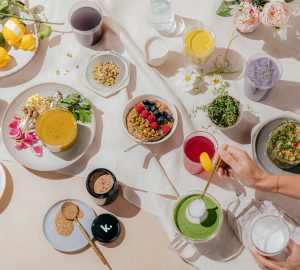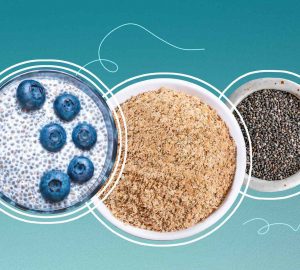Just like opening your eyes every morning, brushing your teeth and putting on clothes, healthy eating is one of the inseparable parts of our lives: it’s also one of the best parts, and you can’t argue there. We consume food to stay alive, be energized, and feel pleasure: for most people, our brains release dopamine when we eat tasty food.
Now, how do we make sure that we don’t only eat for pleasure but make sure that what we put in our bodies is also nutritious and healthy?
But trying to stay on the straight and narrow – eating healthy with the right nutritional intake – can be very daunting. Luckily with technology, there are more ways than ever to keep us on the right path. There is even an app that will help you count calories and identify the nutritional facts in your daily meals. All you need to do is make a change in your mindset and follow some healthy eating habits. Let’s dive in and identify some.
Cook More at Home
One of the most important and simplest tricks for healthy eating is cooking at home more. And when I say cooking at home, I don’t mean throwing a frozen pizza in a microwave while opening a box of cheap wine. I mean actually chopping vegetables with a good quality knife that you can check out from https://www.trustpilot.com/review/kamikoto.com, grilling chicken, and preparing a fresh lemonade from real lemons Moreover, when you cook the meals yourself, you’ll be more conscious about what you eat and make better choices. It has been shown that overall home-cooked meals have lower salt and lower sugar than prepared foods or the ever-tempting restaurant options. You can also consider dietary supplements if you don’t have the time to prepare healthy meals or snacks.
And if you catch yourself thinking that the dust on the dinner table is getting thicker every day, then it’s time to make a change: sit and eat dinner at a table. Also, it turns out, that we are less distracted and stressed when we eat at home and that, in turn, helps our bodies absorb nutrients more efficiently.
Track Calories and Nutritional Facts
As the FDA suggests, there is a standard 2.000 calorie diet that we should follow. But what’s goes hand in hand with counting calories? Counting nutrients! But how do you do that when you are cooking from scratch? Technology to the rescue!
The easiest way to identify the nutrients in your home-cooked meals is to use an online recipe analyzer tool like RecipeIQ. This app will give you the nutritional facts from any recipe: from a web page or even from a newspaper, magazine or cookbook. So if you’ve found an unusual chicken broccoli salad recipe online, you can use the app to calculate the calories and the nutritional facts of the dish. And, if you have an apple pie recipe in your cookbook, you will just need to take a screenshot of the recipe, and the app will analyze the rest for you. Discovering all the nutritional information about your meals will be your first step towards living a healthier life.
Some of the important nutrition facts to consider in your recipes are the following:
- Fat
- Fiber
- Carbohydrates
- Iron
- Sugars
- Cholesterol
With the app, you will be able to find out information about all of the nutritional facts in your own recipes.
Choose fruits, vegetables, and whole grains
You need the natural fiber that is in fruits: so when you find yourself reaching for an orange juice, move your hand away and reach for an actual orange. Next, comes vegetables: they come in a variety of colors and types. It’s necessary to make them a healthy eating habit and have those bell peppers and carrots on your table instead of a Snickers bar. And, of course, whole grains: have at least half of your cereals and pasta made from whole grains.
Consider low-fat milk, lean meats, and protein
You might not be a real lover of milk. If that’s the case, then choose low-fat or fat-free milk, but make sure to have some because these provide calcium and vitamin D. And you need those to keep your bones strong. If you’re trying to stay away from meats or don’t enjoy their taste so much, there are other alternatives. Choose lean cuts of meat and poultry since these have fewer calories and less fat, but are still considered to be a good source of protein. Don’t want to have red meat at all? Then you’ll have to replace them with fish, beans or tofu.
Turn one meal into many and pack up your leftovers
As you know, eating small meals throughout the day is better than having one or two giant dinners.
The reason behind is that frequent snacking, of course, only if it’s healthy, keeps our metabolism humming, staves off hunger, and also controls blood sugar. What’s the result? We eat less but don’t feel hungry throughout the day.
In fact, since our childhood, we’re told that we should always eat everything that’s on our plate, even if we’re feeling full. The truth is, you don’t have to finish every bite: when we keep chewing even after you’re feeling full, we’re using our body as a storage unit. Imagine?
Always reach for water
Pam Bede, M.S., R.D. with Abbott’s EAS Sports Nutrition says that staying well-hydrated helps our bodies function properly, and also helps us stay away from overeating. Moreover, more often than we think, we’re simply thirsty, but we confuse it with being hungry.
Why is good nutrition important?
Generally, when we think of good nutrition, we actually think of maintaining a healthy weight. However, its benefits go beyond it: good nutrition will help you live longer. How?
- It reduces the risk of major diseases like diabetes, stroke, osteoporosis, heart disease and more,
- It helps maintain healthy blood pressure,
- It improves your overall well being,
It is crucial to take good care of our bodies every single day. And we can do that with consciously knowing what we are putting in our bodies through practicing healthy eating .








